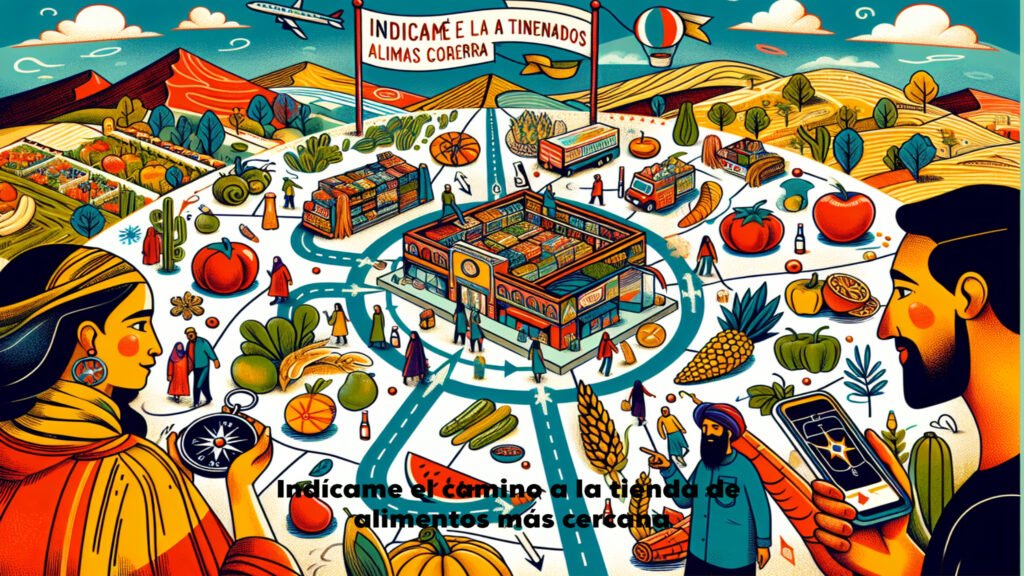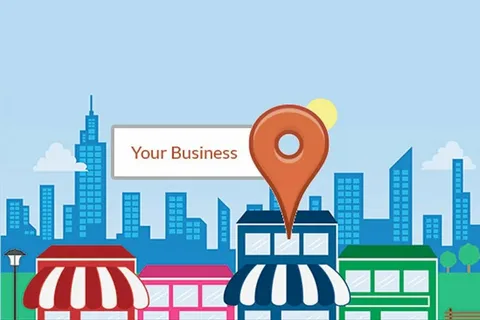
Introduction:
indícame el camino a la tienda de alimentos más cercana, In our modern world, convenience has become a cornerstone of everyday life. Whether it’s ordering groceries online or using GPS to find the nearest store, technology has made it easier than ever to access the goods and services we need.
Among these conveniences, the ability to ask for directions to the nearest grocery store (“indícame el camino a la tienda de alimentos más cercana” in Spanish) stands out as a testament to the integration of technology into our daily routines. In this article, we will delve into the intricacies of this seemingly simple request, exploring the technology behind it, its implications on society, and the broader context of convenience culture.

Understanding the Request:
“Indícame el camino a la tienda de alimentos más cercana” translates to “Show me the way to the nearest grocery store” in English. This request exemplifies the fusion of language and technology, as it harnesses the power of voice recognition and geolocation services to provide users with real-time directions.
Must Read=how i sleep at night knowing l’m failing all my cl – tymoff
Voice Recognition Technology:
Voice recognition technology, also known as speech recognition, enables computers to interpret and respond to human speech. When a user utters the phrase “Indícame el camino a la tienda de alimentos más cercana” into their device, the system employs algorithms to transcribe the spoken words into text. Natural Language Processing (NLP) algorithms then analyze the text to identify the user’s intent, in this case, the desire to find the nearest grocery store.
Geolocation Services:
Geolocation services utilize Global Positioning System (GPS) data to determine the precise location of a user. When a user requests directions to the nearest grocery store, their device communicates with GPS satellites to ascertain their current coordinates. These coordinates are then sent to mapping services, such as Google Maps or Apple Maps, which use them to generate directions to the closest grocery store.
Implications on Society:
The ability to ask for directions to the nearest grocery store has profound implications on society, particularly in the realms of convenience, accessibility, and urban planning.
Convenience:
In our fast-paced world, convenience is highly valued. The advent of voice-activated navigation systems has made it easier than ever for individuals to access essential goods and services. Whether you’re a busy professional grabbing groceries on your way home from work or a parent juggling multiple responsibilities, the convenience of simply asking for directions can save valuable time and energy.

Accessibility:
For individuals with disabilities or mobility impairments, technology has been a game-changer in terms of accessibility. Voice-activated navigation systems empower users to access essential resources, such as grocery stores, with greater ease and independence. By eliminating the need for manual input, these systems ensure that everyone, regardless of their physical abilities, can navigate their surroundings effectively.
Urban Planning:
The widespread adoption of voice-activated navigation systems has also influenced urban planning and infrastructure development. As more people rely on technology to find their way around cities, there is increased pressure on local governments to ensure that essential services, such as grocery stores, are easily accessible. This may lead to changes in zoning regulations, the establishment of new businesses, and the development of transportation infrastructure to accommodate the needs of residents.
The Broader Context of Convenience Culture:
The request for directions to the nearest grocery store is emblematic of a broader cultural shift towards convenience. In today’s society, we expect instant access to information, goods, and services at the touch of a button or the sound of our voice. This convenience culture has been fueled by advancements in technology, such as smartphones, GPS, and voice recognition, which have revolutionized the way we interact with the world around us.
However, while convenience offers undeniable benefits, it also raises important questions about the impact on human behavior, societal norms, and environmental sustainability.
Human Behavior:
The convenience afforded by technology has reshaped human behavior in profound ways. We now rely on our devices to perform tasks that were once considered mundane or time-consuming, such as grocery shopping or navigating unfamiliar streets. This reliance on technology can lead to a loss of certain skills, such as spatial awareness or map reading, as well as a decreased tolerance for inconvenience or discomfort.
Societal Norms:
As convenience becomes increasingly ingrained in our daily lives, it shapes our societal norms and expectations. We now expect services to be available on-demand, tailored to our individual preferences, and delivered with minimal effort on our part. This has implications for industries ranging from retail and hospitality to transportation and healthcare, as businesses strive to meet the evolving needs of consumers in an increasingly convenience-driven market.
Environmental Sustainability:
While convenience offers undeniable benefits in terms of efficiency and productivity, it also has environmental consequences. The reliance on technology, particularly in the form of smartphones and other electronic devices, consumes significant amounts of energy and resources. Additionally, the convenience of online shopping and home delivery contributes to increased packaging waste and carbon emissions from transportation.

FAQ
- What does “Indícame el camino a la tienda de alimentos más cercana” mean?
- This Spanish phrase translates to “Show me the way to the nearest grocery store” in English.
- How does the voice recognition technology behind this request work?
- Voice recognition technology transcribes spoken words into text and analyzes them using Natural Language Processing (NLP) algorithms to identify the user’s intent.
- What are geolocation services, and how are they involved in this request?
- Geolocation services utilize GPS data to determine the user’s precise location, which is then used to generate directions to the nearest grocery store.
- Is this feature available on all devices?
- Yes, most modern smartphones and devices with voice assistants such as Siri, Google Assistant, or Amazon Alexa support this feature.
- Can I use this feature while driving?
- Yes, but it’s essential to prioritize safety. Consider using hands-free options or pulling over before making the request.
- Are there any privacy concerns associated with using this feature?
- The use of geolocation services raises privacy considerations. Users should be aware of the permissions granted to apps and services when using location-based features.
- How accurate are the directions provided?
- The accuracy of directions depends on the reliability of GPS data and the mapping service used. Generally, directions are quite precise, but occasional errors may occur.
- Can I specify the type of grocery store I’m looking for?
- Some voice assistants allow users to specify preferences, such as organic, vegan, or specialty stores, to tailor the search results accordingly.
- Is this feature available offline?
- Some mapping apps offer limited offline functionality, allowing users to download maps and directions for offline use. However, real-time updates and navigation typically require an internet connection.
- Can I use this feature in different languages?
- Many voice assistants support multiple languages, allowing users to make similar requests in various languages depending on their preferences.
- What if there are multiple grocery stores nearby?
- The mapping service will typically provide a list of nearby grocery stores, along with their respective distances and directions, allowing users to choose the most convenient option.
- Can I use this feature to find other types of stores or services?
- Yes, similar voice commands can be used to find other types of stores or services, such as pharmacies, restaurants, gas stations, and more.
- Are there any additional features or tips for using this feature effectively?
- Users can often customize their preferences, such as avoiding toll roads or highways, selecting alternate routes, or adjusting arrival time estimates.
- Can I save my favorite grocery stores for quick access?
- Some mapping apps allow users to save favorite locations, including grocery stores, for quick and easy access in the future.
- What if I’m in an unfamiliar area and don’t know the name of any nearby stores?
- Users can simply request directions to the “nearest grocery store” without specifying a particular name, and the mapping service will provide relevant results based on the current location.
- Are there any accessibility features for users with disabilities?
- Voice-activated navigation provides an accessible option for individuals with disabilities or mobility impairments to navigate to essential services independently.
- Can I share the directions with others?
- Yes, users can typically share the directions with others via text message, email, or through various social media platforms.
- Can I use this feature in rural areas where GPS signals may be weak?
- GPS signals can sometimes be weaker in rural or remote areas, which may affect the accuracy of directions. It’s essential to have a stable connection for optimal results.
- How often are the mapping databases updated?
- Mapping databases are regularly updated to reflect changes in road networks, new businesses, and other relevant information, ensuring the accuracy of directions.
- Is there customer support available if I encounter any issues with this feature?
- Most mapping services offer customer support channels, such as help centers, online forums, and direct contact options, to assist users with any questions or issues they may encounter.
Conclusion:
In conclusion, the ability to ask for directions to the nearest grocery store represents more than just a simple convenience—it is a reflection of the profound impact that technology has had on our lives. From voice recognition to geolocation services, the intricate network of algorithms and data systems that powers this capability is a testament to human ingenuity and innovation. However, as we embrace the convenience of modern technology, it is essential to consider the broader implications on society, culture, and the environment. By striking a balance between convenience and sustainability, we can harness the power of technology to improve our lives while also preserving the world for future generations.



